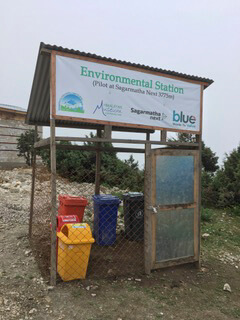Everest fights back
(against garbage and bad press)Mt Everest has been called the ‘The World’s Highest Garbage Dump’ or ‘The Toilet Paper Trail’, but the international media has missed the good news: that Sagarmatha National Park is cleanest it has been since tourism started in the 1960s. And it is about to become even more garbage free as every visitor will be asked to volunteer to take down 1kg of trash back for collection by recyclers at Kathmandu airport.

Photo: TOMMY GUSTAFSSON

Photo: ALTON C BYERS
A ‘Carry Me Back’ bag that will contain 1kg of pre-processed solid waste that tourists will carry back to recycling facilities in Kathmandu.
The spring 2019 climbing season saw another surge of international media coverage with daily stories of ‘traffic jams’, newly exposed garbage, bodies and helicopter parts that surfaced as the mountain thawed due to climate change.
Some 400 tons of plastic, metals, glass and other refuse is generated each year by lodges catering to the tourist industry, the bulk of it burned and buried in some 75 community landfills located near villages along the Everest Trail. Burnable garbage includes plastics that poison the air, contaminate the water, and create new health hazards for humans and livestock alike.
Read Also:
Living below Nepal's melting mountains, Alton C Byers
High Water, Alton C Byers in the Barun Valley


Typical garbage pit outside of a village, usually out of sight of the main trekking trail. Landfills are particularly problematic in the alpine zone above 4,000m, where decomposition processes are much slower than those at lower, warmer and more humid environments. Photos: ALTON C BYERS

It hasn’t always been this way. When I first visited the Khumbu in 1973, there were no lodges, the total number of tourists per year was under 2,000 and virtually no solid waste was produced. Food came in reusable packaging (doko baskets, cloth bags) and meals consisted of rice, lentils, potatoes and some vegetables.
By the 1980s and 1990s a few lodges started being built, and trekking groups camped in village potato fields rented out by landowners. By the early 2000s the rush to build lodges to feed and shelter the growing numbers of tourists took off, transforming the cultural landscape. With lodges came both greater tourist numbers as well as an increased demand for consumables like beer, whiskey, wine, bottled water, fruit cocktail, sunscreen, TVs and batteries, with their non-biodegradable packaging. It all ended up in refuse pits to be routinely burned.


Going by the international press narrative, the problem is bad and getting worse. Are the Sherpa people, Sagarmatha National Park and government doing nothing about it? Far from it. More than 20 years ago, the Sagarmatha Pollution Control Committee (SPCC) was launched as a local initiative to manage waste. Since then, the SPCC and its partners have installed 106 waste collection centres throughout the park, banned glass beer bottles, organised annual Base Camp clean ups, conducted compost trainings, and continually look for new and innovative solutions to the challenges of managing the waste generated. Not much of this is reported by the international media.

During two solid-waste workshops facilitated by the University of Colorado and Arizona State University in Namche Bazaar and Kathmandu last month, local stakeholders were looking for innovative new ways to manage the waste of 60,000 trekkers and climbers, plus their support staff, who are in the park every year. The SPCC is now working with Sagarmatha Next, which is setting up segregation stations for a ‘carry me back’ program, where every tourist agrees to take back 1kg of waste to recycling centres in Kathmandu.
The trek from Lukla to Everest Base Camp has long been referred to as the ‘toilet paper trail’ -- today it is anything but. In spite of the growing numbers of visitors, support staff and pack animals, it is one of the cleanest and most beautiful treks in the high mountain world.

Of course, a lot more needs to be done. Participants at the Namche and Kathmandu workshops stressed the need for innovation to deal with solid waste in a location-specific way, while being sensitive to local culture and values. The first step is establishment of waste separation centres, pre-processing facilities (shredding, compacting, baling) and finding way to transport the material to recycling centres in Kathmandu and elsewhere. Some of the aluminium and plastic waste is already being turned into ‘Everest Art’ to be sold for fund-raising. Aluminium cans are also converted into utilitarian objects like frying pans and other utensils. Human waste can be addressed through new solar technology, and more efficient septic tanks can prevent leakage.
As a first step, Colorado and Arizona will be working with the local government ahead of the autumn trekking season to follow up the recommendations of the workshops. A landfill-free and waste-free Sagarmatha National Park, where garbage is not burnt, can be a reality in a few years. It could provide a much needed model for other mountain areas where the problems of tourist-related solid and human waste management exist.
The difference is, things get done in the Khumbu.



Photo: TOMMY GUSTAFSSON

Photo: ALTON C BYERS
Sagarmatha Next's Interpretation Centre in Syangboche.
Alton C Byers, PhD, is a mountain geographer, conservationist and mountaineer specialising in applied research, high altitude ecosystems, climate change and glacier hazards. Field work for this project was supported by a grant from the National Geographic Society.




